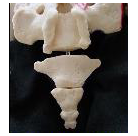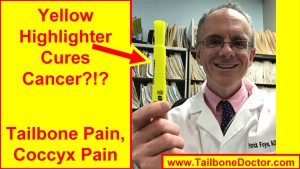Yellow Highlighter Cured Cancer?!? Tailbone Pain, Coccyx Pain.
- The video is at the bottom of this page. Here is the text:
- I’m going to tell you a story that’s crazy, but true, of how I used a yellow highlighter to cure cancer in my father-in-law and then I’ll tell you how it’s related to tailbone pain.
- I’m Dr. Patrick Foye. I’m an M.D., or medical doctor, and I’m the Director of the Coccyx Pain Center or Tailbone Pain Center here in New Jersey.
- About 20 years ago, shortly after I first got married, we got a phone call from my wife’s family in the Midwest, Chicago area, that my father-in-law, who was in the hospital in Chicago (he’s a former Notre Dame football player) and unfortunately they saw on his imaging studies what looked to be a cancer in his lungs.
- And it was actually pretty clear that it looked pretty bad, pretty destructive.
- It showed up incidentally on some imaging studies that he had done while he was at in the hospital for something unrelated.
- And the plan was for him to have a biopsy where they would basically make a small surgical incision in the skin and they would go in and take a sample of tissue so that they could send it to the pathology to do slides to take a look and figure out exactly what type of cancer it was and all of that.
- And he told them at the hospital, he said “well, you know, my son-in-law is a doctor.
- He’s in new jersey and my and my daughter is there. Can you fax them a copy of the imaging results?” And the hospital did.
- Now what I did when I got the imaging results was the exact same thing I pretty much always do when I get imaging results, which is I take a yellow highlighter and I highlight the important factors in the report.
- It’s something I’ve been training medical students and residents.
- It’s incredibly simple, right? It’s not rocket science.
- And the very first thing that I typically always highlight is the patient name.
- So I get the fax and I highlight the patient name.
- But it’s not his name.
- It wasn’t his imaging results.
- And it turned out that somehow someone else’s report got mixed up into his chart.
- And they were planning this whole diagnostic workup the family was sort in a in a whole kerfuffle worried that he had cancer when indeed he had no cancer at all.
- It was somebody else’s report that happened to make it into his chart.
- And apparently the medical team there hadn’t noticed and they thought it was his.
- So they were consulting other doctors to do the biopsy and everything else.
- And so that was basically a very very simple step of using a yellow highlighter to you could sort of say “cure” cancer.
- At least in his case, that he was thought to have cancer and with one stroke of a yellow highlighter no longer had cancer when we called the team out there and got that all straightened out.
- Now, how is this related to tailbone pain, which is what I treat?
- I’m the Director of the Coccyx Pain Center (Tailbone Pain Center) here in new jersey, online at www.TailboneDoctor.com and it’s related to tailbone pain because patients come in to see me from all over the country and occasionally internationally.
- And we typically tell them to bring with them any reports that they have from previous imaging studies that they’ve had of the tailbone, procedures they’ve had from surgeries or injections at the tailbone.
- But even for patients who can’t make their way here to New Jersey to see me in person, my recommendation would be collect your medical records, your radiology reports from your x-rays your MRIs, your CT scans, bone scans, whatever studies you may have had done.
- And take a simple yellow highlighter.
- And what I recommend is that you highlight number one your name (to make sure that it’s actually your report), the date for when it was done, and highlight (if your main symptom is coccyx pain or tailbone pain) highlight the word coccyx or tailbone or coccygeal anytime that that appears in the report.
- And I guarantee many of you will be shocked to find out that your x-ray report, or your MRI or CT report, never even includes the word coccyx or tailbone! That the radiologist never made any comment whatsoever on the appearance of your coccyx, the appearance of your tailbone, even though that was the presenting symptom the main reason that you went in for the evaluation in the first place.
- I know that that probably sounds really crazy, but i see this practically every single day here at the coccyx pain center when patients come in and we look through their reports.
- And they’re shocked to realize they’ve had this pain going on for years and years, they had the imaging studies done years ago, they were told everything was normal and in fact the radiologist never actually looked at the tailbone at all.
- And often the imaging studies never even included the tailbone at all! It was done of the lumbar spine.
- So it’s a really really simple tip that often can pay big dividends because you can then go back to your doctor and say “hey, the imaging studies that were done for my tailbone did they even include the coccyx? The radiologist didn’t make any comment on it.
- Or the physical exam notes from the physician never included documentation of a physical exam of the coccyx..
- Or the procedure note shows that the procedure that was done was an injection at the lumbar epidural space or at the sacroiliac joint or a caudal epidural, none of which are an injection specifically at the coccyx.
- So, again, many of you will be surprised what you can find out just by reviewing your medical records.
- Collect your medical records.
- Use a yellow highlighter.
- Yellow is really good because if you need to make photocopies the yellow is light enough that you’re not going to obscure or blacken out the information that you want.
- So don’t use a blue or orange highlighter. They’re not as good for those purposes.
- There’s a there’s a whole chapter in my book which is Tailbone Pain Relief Now! I have an entire chapter in the back about collecting and have how to handle your medical records and navigate the healthcare system and some of the caveats or the hurdles that are in place for people with tailbone pain.
- Because it’s often sort of this black box that physicians, radiologists, pain management doctors, musculoskeletal physicians, don’t pay attention to some of those details.
- So, again, use the yellow highlighter because it can really it can really help you to see what was missed on your imaging studies.
- Or perhaps the imaging studies are not yours at all!
- Okay, again, I’m Dr. Patrick Foye.
- Online you can find me at www.TailboneDoctor.com
- Or if you’re interested in getting a copy of the book “Tailbone Pain Relief Now!” which is 272 pages all about the tailbone (diagnostic workup, treatment, etc.) that is available: on Amazon is probably the easiest way to find it if you just put in “TAILBONE” and the word “FOYE” (my last name) (spelled “F as in Frank, O – Y – E”) you can find that there.
- So anyway I hope that’s helpful for you.
- Use your highlighter you’ll find it super helpful.
- All right. Bye-bye.
Here is the VIDEO:
Tailbone Pain Book:
To get your copy of Dr. Foye’s book, “Tailbone Pain Relief Now!” click on this link: www.TailbonePainBook.com

Book: “Tailbone Pain Relief Now! Causes and Treatments for Your Sore or Injured Coccyx” by Patrick Foye, M.D.
Latest posts by Patrick Foye, M.D. (see all)
- Coccygectomy: Expected Recovery and Return to Work after surgery for coccyx pain, tailbone pain. - November 28, 2023
- PRP Platelet Rich Plasma or Prolotherapy for Tailbone Pain, Coccyx Pain - October 25, 2023
- Reasons for Normal X-rays and MRI Despite Tailbone Pain, Coccyx Pain - October 3, 2023


